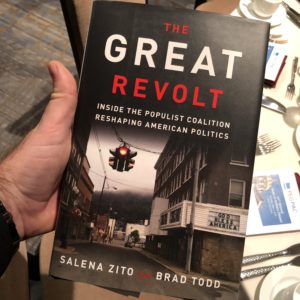
Salena Zito has been a political journalist for almost 15 years. Her rule for traveling is “no planes, no interstates and no hotels.†While many pundits, journalists, political strategists, and the like tend to fly over the rural and industrial areas of America, Zito stays at the local bed-and-breakfasts and eats at the local diners. This dedication to getting to know Middle America has given Zito a compelling vantage point for understanding the 2016 election. Her book The Great Revolt (co-written with Republican strategist Brad Todd) introduces us to the counties and citizens who put Donald Trump in the White House.  Through a compelling mix of anecdotal insight, extensive number-crunching, and substantive analysis, the book showcases “the populist coalition reshaping American politics.â€
The authors identify several archetypal Trump voters, from the much-discussed Evangelical to the Independent who only votes once in a blue moon. The section on the white working class voter contains several surprises. The authors note that “among those surveyed for this book in this demographic, 84% were actually optimistic about the future of their career, even as they expressed concern for their communities.†(20.) In addition, this voter group “ranked Trump’s promise to bring back manufacturing jobs as more important than his promises to protect safety-net programs or his pledges to build a wall on the Mexican border or put conservative judges on the Supreme Court†(20.) On a much more sobering note, “fully half of this group reports that they know someone personally who has battled drug addiction.†(21)
Similar to this group is another voter demographic that the authors call the Rough Rebounders, who tended to be Trump’s fiercest supporters.
Regarding this group, the authors write: “whether they were bouncing back from foreclosure, bankruptcy, multiple family breakups, or business calamity, Rough Rebounders saw in Trump something they wanted to believe about themselves – a resilient and unconventional survivor who seemed tougher than his critics and his obstacles.†The authors note that “Trump’s missteps and gaffes and penchant for saying the impolite, the inappropriate, or just the inaccurate, endeared him even more to many of these voters.†(79)
Another fascinating voter group identified by the authors is the Rotary Reliables. Here’s the demographic summary:
“The Rotary Reliables are at the top of the pyramid in their communities, the kind of people who run the factories, banks, and civic organizations. But unlike the upper class congregating in the nation’s most elite zip codes, these voters spend much of their lives intersecting not with fellow college-educated professionals, but with working-class voters. They hunt and fish with them, they share PTA duty at school with them, they sit on the same church pews. Unlike the corporate manager who lives in a cul-de-sac outside Dallas or Philadelphia, these college-educated voters in less-educated communities knew plenty of people who were not only voting for Trump, but were enthusiastic about him.†(145)
The most important thing to note about this voter group is that they “voted with their neighbors and not their economic or educational class†(146.) The authors explain that “the sense that Trump was looking at the overlooked, and fighting for the forgotten in Middle America, enabled him to succeed with the upper-middle-class votes in places like Erie who are scarcely different demographically from the suburbanites who were the weakest part of the Trump coalition†(159.)
The broader county-based data analysis is a particular strength of the book. The authors draw attention to the sheer number of counties that were crucial to Trump’s election:
“Thirty-five counties in Ohio, long the nation’s premier presidential bellwether, swung 25 or more points from 2012 to 2016. Twenty-three countries in Wisconsin, thirty-two counties in Iowa, and twelve counties in Michigan switched from Obama to Trump in the space of four years. With few exceptions, these places are locales where most of America’s decision makers and opinion leaders have never been.†(3) On the other hand, “of the forty-four mega counties in the nation with populations over one million, Trump carried only three – Tarrant County, Texas, which includes Fort Worth; Maricopa County, Arizona, which includes Phoenix; and Suffolk County on Long Island, New York†(144.) In these counties “Trump’s net margin of votes in mega counties was worse than Romney’s in thirty-two of the forty-four†(144.)
A surprising finding is that “Trump did very well among the college-educated in counties farther away from major cities – a vital component of the record margins he assembled in those non-metropolitan counties†(144.) Though, as might have been expected, “in counties with far more than the national average of 29.8 percent of adults with bachelor’s degrees, Trump fared poorly. Of America’s one hundred most educated counties, he carried only nineteen – Romney had carried twenty-six†(144.) Regarding these findings, the authors summarize that “Americans who live their lives among a group of friends and neighbors with varied educational backgrounds preferred Trump more than Clinton or Romney, while college-educated Americans who live exclusively among other degree holders were less likely to support Trump, even if they were otherwise Republican†(145.)

The book also features insightful analysis of specific counties that voted for Trump such as Luzerne County, Pennsylvania. The authors write: “traditionally, Luzerne County has been emblematic of the heart and soul of the working-class wing of the Democratic Party. Its residents personified the character traits of the New Dealers; they supported government social programs that served as a safety net for the residents, they were pro-life, pro-gun, they joined unions and churches alike†(28.) Trump’s victory in Luzerne was crucial in securing the state, but it’s rather remarkable that this historically blue county went red. After all, “in 2008, Barack Obama beat Republican nominee Senator John McCain of Arizona by 9 percentage points in this county; he beat Mitt Romney in 2012 by 5 points†(31.) And yet, a mere four years later, Trump beat Clinton in this county by a 20 point margin.
So what does the future of United States politics look like? Zito echoes the notion that there are two Americas. One America is found in the Big Four clusters [New York, Los Angeles, San Francisco, Washington D.C.] which is dominated by various keywords like “cosmopolitan†and “multiculturalism†and “open borders.†That America is powered by the technocratic progressivism on full display in Hillary Clinton’s campaign. And then there is the America that is so diligently detailed in The Great Revolt. Zito writes that “the emerging populist-conservative coalition is in no small measure a resistance to the mores and powers of those Big Four clusters – and the Democratic message of the Obama era has proven to be a purely distilled insistence on conformity to the values, societal norms, and priorities of that hyper-educated, metropolitan class.†Zito explains that “if the people who make branding, news, and political decisions are immersed in environments hostile to a coalition that represents a governing majority of the nation, cultural schism is the most likely outcome.†(236) Zito identifies the NFL controversy as one example of this schism and warns that “the NFL won’t be the last gas tank to combust under the friction of the colliding mores of coastal brands and heartland populists†(257.)
Nevertheless, the idea of an emerging ascendant multicultural coalition of voters remains increasingly plausible as well, and in fact, both the Democratic party and large businesses like Starbucks and Google, are banking on the future of that coalition.  Zito quotes the journalist Ron Brownstein: “in the long run, Republicans have a demographic problem and Democrats have a geographic problem†(263.) The future likely belongs to whichever political party can solve their respective problem the fastest.